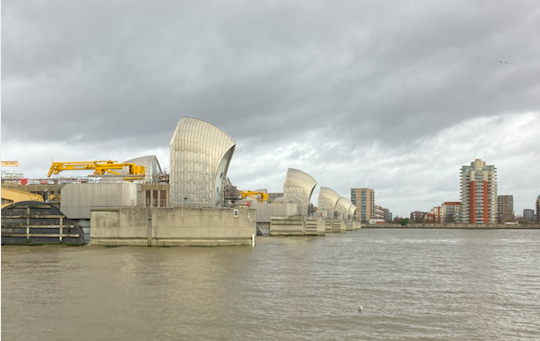
Les travaux de protection contre les inondations de l'estuaire de la Tamise sont avancés en raison du changement climatique
De nouveaux modèles climatiques améliorés ont illustré le risque accru d'inondation dû au réchauffement climatique et à l'élévation du niveau de la mer . C'est pourquoi, selon l'Agence pour l'environnement, elle doit renforcer les défenses en amont de la barrière de la Tamise dans le centre de Londres d'ici 2050, 15 ans plus tôt qu'elle ne le pensait initialement.
Il cherche à protéger plus de 1,4 million de personnes et 321 milliards de livres sterling de biens contre les risques existants liés aux inondations causées par les marées et au changement climatique.
"Le niveau de la mer augmente à un rythme accéléré dans l'estuaire de la Tamise, et il est donc essentiel que nous agissions maintenant pour répondre au changement climatique", déclare Julie Foley, directrice de la stratégie FCRM et de l'adaptation nationale de l'Agence pour l'environnement.
"Notre plan mis à jour reconnaît que le renforcement de la défense doit commencer plus tôt qu'on ne le pensait initialement - d'environ 15 ans. Parallèlement, le plan nécessite également des investissements plus importants dans les habitats et la gestion des inondations naturelles pour soutenir le rétablissement de la nature.
«Nous ne pouvons pas réaliser seuls les ambitions du plan actualisé de l'estuaire de la Tamise 2100. C'est pourquoi nous continuerons à travailler avec de nombreux partenaires pour offrir un estuaire vert et résilient.
Alors que l'agence affirme que la barrière de la Tamise continue de fonctionner de manière fiable et efficace dans le cadre du système de défense contre les inondations plus large et devrait continuer à protéger Londres jusqu'en 2070, elle examine et décide d'une option de fin de siècle d'ici 2040.
Des travaux sur les défenses contre les inondations sont en cours dans toute la zone de l'estuaire depuis le lancement du plan Thames Estuary 2100 en 2012, notamment dans le cadre du projet d'écluses à double fonction de 63 millions de livres sterling à Tilbury, du projet de revêtement de la rive sud de l'île de Canvey et des actifs favorisant la biodiversité à Deptford. .
Le plan demande également que les stratégies riveraines soient intégrées dans les cadres de planification locaux d'ici 2030 pour garantir que le nouveau développement est conçu pour tenir compte des futures exigences de protection contre les inondations.
« Les inondations sont dévastatrices pour les communautés – et leurs impacts deviendront plus extrêmes à mesure que nous affronterons le changement climatique. Nous devrons faire preuve de plus d'adaptabilité et de flexibilité pour faire face à ces menaces », a déclaré la ministre des Inondations Rebecca Pow.
« Le Thames Estuary 2100 Plan en est un parfait exemple : une stratégie d'adaptation climatique de pointe qui nous permet de réagir à l'évolution des circonstances et de garantir la protection des personnes vivant dans l'estuaire de la Tamise à long terme.
Les partenaires, y compris la Greater London Authority, les conseils, la Port of London Authority, les Wildlife Trusts et bien d'autres, continueront de travailler ensemble pour renforcer les défenses contre les inondations plus tôt que prévu afin de s'assurer que les communautés de Londres et de l'estuaire de la Tamise au sens large sont prêtes à s'adapter à la effets du changement climatique.

Plus tôt cette semaine, l'agence a également annoncé que sa saison de test des "eaux de baignade" avait commencé, avec une surveillance de la qualité de l'eau en cours. Cela signifie des tests réguliers sur des « sites de baignade désignés ».
Les travaux de défense contre les inondations de l'estuaire de la Tamise ont été avancés en raison du changement climatique et sont apparus en premier sur Marine Industry News .
